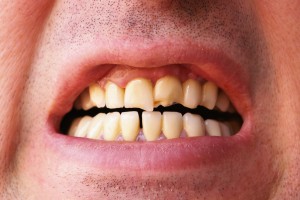
Even with x-rays, these are hard to find since these cracks are usually too fine to be seen on these. Sometimes, these are also hard to locate due to their being found underneath a person’s gums. If this is left untreated, the damage to the person’s tooth will progress to bigger (and oftentimes more painful) dental problems.
These often happen in the lower back areas of your mouth, where the lower molars can be found. These cracks happen due to a number of reasons, such as constant clenching or grinding, or even due to the habit of chewing ice. These cracks can also appear due to accidents like biting into something hard unexpectedly (a bone or a pit) or because of a recent trauma. Whatever the case may be, these can and do occur, and if left unchecked, can result in a broken tooth, infection, and even more pain.
Diagnosing Cracked Tooth Syndrome
There are ways to determine whether a person is suffering from pain due to cracked tooth syndrome, and this is with a diagnosis brought about by an examination by your dentist, with help of knowledge of the symptoms being felt. Some of the more common symptoms that dentists look out for include complaints about pain when chewing or biting, and sensitivity to cold temperatures. The pain is rarely constant and may vary from a mild throb to a tear-inducing jolt.
Dentists often diagnose this with the use of special tools that help them pinpoint exactly where the pain emanates from. The patient will be asked to bite down on a toothbrush-like tool, and if there is pain in the area where the patient bites down on, the crack is more likely to be there. Staining the area with a dye will further help with locating the crack, and will help in exacting a treatment for the problem.
Sometimes, when the crack is under a crown or a filling, your dentist will have to remove these to see the crack better. X-rays may still be taken, although as mentioned earlier, these cracks rarely show on these. A sharp instrument may also be used to probe your teeth to see if cracks can be felt by the tip of such an instrument.
Prevention and Treatments
The most common tip dentists give patients who suffer from these cracks is, in order to avoid or prevent more of these from happening, they will need to rid themselves of such habits as chewing ice, clenching and grinding. They will also be advised to try and be careful when eating or chewing since biting down on hard substances that are in food can also crack a person’s tooth.
Treatments for this problem are not guaranteed to solve it or relieve the person of it. Treatments will also depend on where the cracks can be found, how deep these are, and how large such cracks are. Some of the more common treatments include the use of crowns on such teeth, and root canals. You may also find your dentist removing such a tooth, if the damage is too extensive, and they may also suggest an implant to replace the missing tooth.
If you suspect that you have cracks in your teeth, you should consult with your dentist as soon as possible to prevent the worsening of such a problem. Pain when you chew or when you bite are indicators of such a dental issue. If you are constantly grinding and clenching your teeth, having your dentist check your teeth for cracks is also a must.
- Sleep Dentistry: Enhancing Comfort and Care During Dental Procedures - July 11, 2024
- The Revolutionary Injection Molding Technique for Composite Veneers - June 27, 2024
- Why Are Third Molars Called “Wisdom Teeth”? - June 19, 2024








